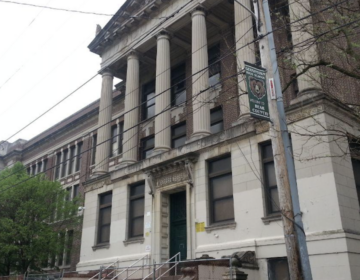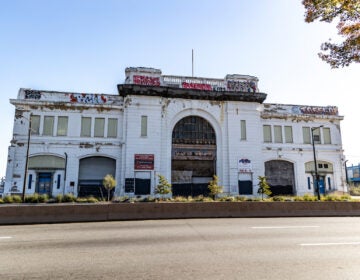Christ Church Q&A

Christ Church Q&A
Respondent: Rev. Timothy Safford
1. Christ Church is one of the city’s architectural and historic treasures, and has had many prominent people in the congregation, most notably George Washington during his time as President. What is your congregation’s role in the history of the waterfront? How does this the congregation’s history, building and place illustrate the role of the Episcopal Church in Philadelphia? What challenges has it faced?
I think it is fair to say that Deborah and Benjamin Franklin are the most prominent historic members of our congregation, rather than President Washington.
The history is long and complex, but I’d say the most important, historically, was the construction of the building that was so massive over the small city, it became the landmark by which ships navigated. When the steeple was completed in 1754, it stood at nearly 200 feet, which made it the highest point in the colonies. It became the major navigational beacon for all river traffic. Further, when maps and pictures of Philadelphia were printed, the Christ Church steeple was the most prominent landmark.
Beginning in 1920 or so, Christ Church became the informal drop in center for seafarers docked at the end of Market.
2. How has your congregational make-up and ministry evolved over the past fifty years? What sorts of people attend services at Christ Church and where do they come from? What has drawn them to this church in particular?
Until the building of the Ben Franklin Bridge, Old City, like Society Hill, was a residential neighborhood, but a poor and unsafe neighborhood. Once the bridge was in, Old City was mostly factories and businesses with fewer than 1,000 residents. Christ Church had a difficult time in the 30’s and 40’s, surviving. The great gift of Christ Church to Old City was anchoring it, and hanging on. Then, when plans for the National Park were started, CC participated in extending the boundaries of the Park down to Christ Church, bringing investment and life to a lost area. The creation of the small park at 2nd and Market opened up the views into Old City, and allowed Christ Church to be seen in all its glory, not blocked by buildings. We are Old City’s oldest continuous business and real estate developer, and the most visited site in Old City.
That being said, though Christ Church has steadily rebuilt its membership over the past 20 years, few of our members come from Old City. Most walk in from Queen Village, Society Hill and other parts of the city. More than half come from outside of the city. People are drawn for many reasons, but mostly because of its strong parish and community life, and the feeling that they are part of a large and expanding witness that has been happening for centuries, and will happen for centuries more.
3. What are some of your thoughts about the gentrification of Old City in the past decade? How has this affected your church’s mission and congregation?
On this question, we take a 300 year perspective. What is the past decade, in a history that spans centuries? In our work with OCCA, Penn Praxis, Zoning, Planning, etc., we always urge to think 100 years at a time. We advocate for Old City become a more intentional neighborhood again, with schools, a supermarket, parks, and a greater sense of community life, not unlike Society Hill, Queen Village, Fishtown, etc. Currently, we’re seen as a hip place to live, for a while, with good restaurants. Old City needs more. Housing for seniors, a real community center, etc. Our mission is the life and health of Old City for the next 300 years.
4. What are your feelings about the proposed waterfront developments, not just casinos but also residential and commercial. How do you feel these will affect your ministry and your church?
Regardless of one’s political persuasions, most Americans take the history and purpose of the United States very seriously. The few blocks between Walnut and Arch, 6th and Front, are a living museum to the most monumental revolution in human history. It is a shrine to all that is wonderful about our nation, and, to all that we are still trying to overcome and move beyond, in the case of slavery, etc. In terms of hallowed ground, Valley Forge is a blip on history’s radar screen. Tradition, events, heroism, needs to be manufactured there. In Old City, it still lives in the cobblestone streets, and in the very bricks and mortar of a place like Christ Church. Seven signers of the Declaration of Independence, Five signers of the Constitution, 13 mayors of Philadelphia, and people who have made history in every generation, are buried in our hallowed ground (see today’s Inquirer, second section, page 1). There is only one institution left in Old City, in its original condition at the same location, still serving the same purpose as it did in 1776, and that is Christ Church. We bring true authenticity to this neighborhood. Could any reasonable person who loves Philadelphia, who wants to guard our history and honor our past, believe that it is right, tasteful, appropriate, to anchor this special place with two hideous casinos? This is not a comment on casinos or gambling; we are realists down here. But would we ever put a casino at the entrance to Valley Forge, or at the edge of Gettysburg, or next to the Pearl Harbor Memorial, or behind the Washington Mall, or on Haymarket Square in Boston? The answer is an obvious “no.” That Philadelphia has allowed the casinos to get this far, and our legislatures have allowed them to be imposed without local control, is further testimony to why we fail as a city. A few days ago, a 14 year old was gunned down by an 18 year old, but Philly can pass gun control laws for our city, and we can pass zoning laws that protect our most historic district. It is all a crisis of leadership.
The waterfront from Spring Garden through Snyder should be the most inviting, lovely, and open waterfront in the nation, easily accessible to Old City. Certainly, there should be development and commercial enterprise, but one that fits the history and integrity of this district, and keeps the historic skyline intact as much as possible. Wouldn’t it be nice to see, one hundred years hence, the 95 buried, and the views from the river between the bridges similar to what Franklin and Penn saw in the 18th century, with the exception of bikers and joggers running along the river walk, like they do today along the Schuylkill.
5. What do you see as the future of Christ Church?
To be doing 300 hundred years from now what we are doing today, in the same building, God willing.
WHYY is your source for fact-based, in-depth journalism and information. As a nonprofit organization, we rely on financial support from readers like you. Please give today.






